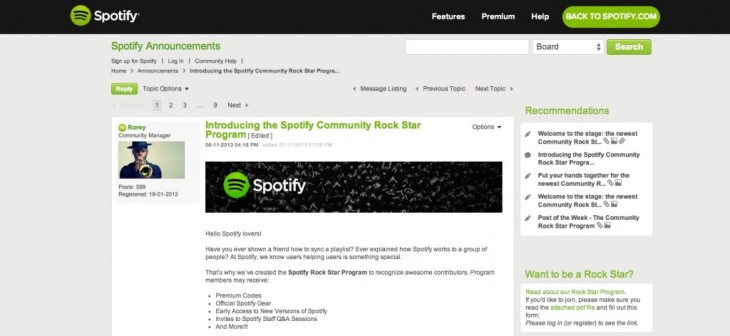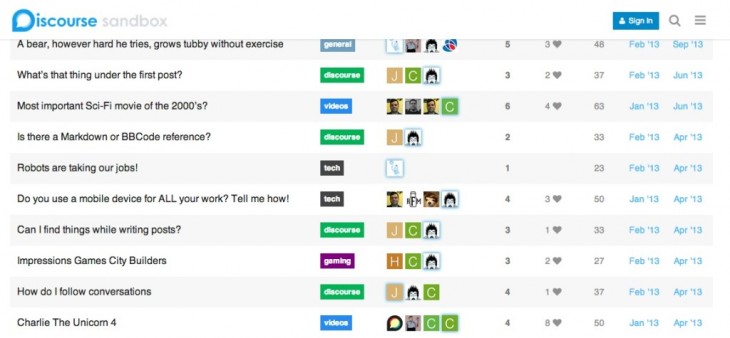
Maria Ogneva is the Head of Community at Sidecar. This post originally appeared on the CMX Hub.
Choosing an online community platform is one of the biggest challenges for a community builder. While an online platform does not equate to a community, when done well, online community platforms are incredibly effective at organizing, amplifying, guiding and scaling a community strategy.
The big problem with platform selection is that the process is time-consuming and characterized by a wide breadth of offerings, lack of standards and a ton of misinformation.
I recently selected the Sidecar online community platform, and I wanted to share the experience in order to guide others through the process.
Lean community and starting small
While thinking big and into the future is important, look for a way to test the community concept before you get into vendor selection. Start small (perhaps with a free platform or a mailing list) and test your assumptions before you charge ahead with launching a big, expensive platform.
For us, the lean community experiment happened on Facebook. We tested and observed how members interacted for about a year in secret Facebook groups.
We saw, time and time again, our members wanted to find and share with each other. Knowing our community’s motivations made the platform search process easier, as I could place each product demo in the context of our existing community. If you don’t have strong hypotheses for how your community will interact on your platform, the salespeople from platform vendors will fill in the blanks for you. And that is not a safe bet.
Once you are ready to select and implement the platform, you should still take a lean approach. Get something out quickly, learn how people are using it, and then iterate after you have actual usage data.
Behaviors, not features
After you’ve validated your community concept, get clear about your goals. Instead of feature lists, focus on the kinds of behaviors you want to establish instead.1
Sidecar is the marketplace for people to give and get rides from their mobile phone. Our job is to build a community of grassroots action and mutual trust. We especially focus on drivers coming together to share, learn, perfect their skills, and for us to engage in open and honest dialogue with the driver community. Our platform should enable all of that to happen easily.
Go ahead and establish a few of the non-negotiable characteristics of your community. Here were ours.
Our five community non-negotiables
1. Global, local and deeply collaborative
Our business is all about local, decentralized execution that can happen on a global scale. While some companies want to own the process and the outcome, the highest expression of community for us is when members meet and collaborate with each other and without our involvement.
To that end, we needed a trusted, private community with spaces that would be accessible and relevant to all, alongside spaces that maintained local context. We knew that groups (much like groups on Facebook) are better at supporting deep collaboration and action than a simple Q&A forum.
2. Mobile
For obvious reasons, mobile was a huge priority and a non-negotiable for us. This is a big sticking point as most platforms still don’t think mobile-first. Having this as an elimination hurdle made the selection process much easier.
3. Easy to use
While researching platforms, I was troubled by dated User Interfaces (UIs) and forums that looked like they were designed in the 80′s. Instead of simplifying, a lot of platforms added random features.
This results in feature bloat and makes them more complicated to use. Our community members needed a place that’s easily accessible and easy to use, on the computer and their mobile device. It had to be easy to contribute.
4. Flexible and agile
Your community is going to change, and so is your company. It’s less than half the battle to have an engaging, relevant community on day one. You need to continue to be top-of-mind and fresh in terms of UI and content. We have a small, agile team, and without a designer or developer on my team, I needed something that we could update easily on our own.
I needed a UI that would present posts and media in engaging ways — making it easy to promote and highlight content. JiveX – the solution we chose – has some great widgets, reminiscent of WordPress, that curate and feature content and members.
5. Integrated into existing systems
While you’re designing a community platform for today, have some fun and envision the future. While you should avoid building any massive customizations that will weigh you down, you should know how the platform connects to various systems you use: support, email/customer journey, sales, customer recruitment, etc.
At some point, we’ll want to connect our platform to our product and our workflows. To that end, I was thrilled that JiveX has a mobile SDK and integrations into work systems that are important to us.
Build vs. Buy? Small business vs. Enterprise?
Here’s the rub. There’s not one perfect tool, because it’s impossible for one platform vendor to be all things to all communities. While there will be a lot of variation across tools and approaches if you’re buying from a third-party, we can roughly generalize in three broad buckets of platform types.
Bucket #1: Enterprise-Grade Platforms
Unless you’re wielding big budgets, massive customization, and your own engineering team, on-premise implementation is a risky and expensive idea. So it’s likely you’re going to want to go with a cloud solution.
Being able to customize for your needs is valuable, but you have to weigh that against the costs and a slowdown in your time-to-market. Again, it all depends on your priorities.
In this group, I looked at three main competitors: JiveX, Lithium and Salesforce.
JiveX
This is the platform we chose because it was the easiest (and most affordable) to stand up, and a widgetized layout made groups and homepages a breeze to customize on the fly.
We highlight and feature content weekly, and the widgets are always changing to move in lockstep with what’s important to the business. And since we’re coming from the Facebook experience, we wanted to stay close to that.
Most importantly, JiveX had the best mobile experience of all the platforms we talked to, both via responsive web and native apps. Having gotten to know the product team, I feel comfortable that they will hit it out of the park with mobile experience and general usability.
Here’s a sneak peak at what our community looks like. It’s called The Garage — cute, huh?
Lithium
While a gold standard in communities with a pedigreed track record and market reputation, Lithium can be complex and pricey to set up and maintain. It’s a powerful product with features that have been honed over the years, but the level of customization necessary to stand it up and maintain wasn’t right for us at this time (again, a team of engineers behind you would be helpful if using Lithium).
At the time of our platform selection, Lithium was still largely Web-centric vs. mobile-first in its approach, and the mobile experience, which was our major sticking point, was weaker here than in other platforms.
Lithium does work great for community at companies like Spotify (above) and FitBit.
Salesforce Communities
Similar to Lithium, Salesforce Communities is a solid option with a pedigree in customer experience and worker productivity, and it has a whole suite of leading technologies built on the Salesforce platform. This means that there’s great potential and powerful integrations into existing technologies. If you’re a Salesforce shop, it’s worth checking out.
However, the Communities product was still in its early days as we were picking out our platform. Similar to Lithium, it’s pretty complex (and expensive) to set up and customize.
Salesforce Communities is a powerful platform for partner engagement and for anything that relies on Salesforce products – but for us, it was a bit too powerful.
My analysis of enterprise tools wouldn’t be complete if I didn’t caution against some downsides:
- Enterprise platforms tend to be complex and expensive, which can be daunting in terms of both the learning curve and the cost to bring to market.
- You are always at the mercy of the platform vendor’s roadmap, and larger vendor companies tend to have more internal and external politics (not a rule, just an observation).
- These politics often result in building too many features without the discipline of honing the existing offerings. The resulting complexity often leads to lowered adoption and engagement.
Bucket #2: “SMB”/Smaller platforms
While it’s a huge testament to Sidecar’s focus on community that I was empowered to pick the right platform — even if it wasn’t the cheapest — we had to check out some more modestly priced options.
We looked at lots of mid-tier “SMB” (small business) platforms, which were fantastic in their own way. But most of them seemed to focus on one aspect of community like content curation or link-sharing, while very few nailed a holistic experience.
GetSatisfaction, for instance, is fantastic for support, Q&A and ideation. While it’s a solid performer, it ended up not supporting a lot of our other use cases.
One platform that seemed to hold promise, and one that I’ll be tracking going forward, is Discourse. Featuring an updated UI and more modern interaction flows, it’s not yet open for commercial use, as of the time of this writing.
You can, however, implement a Discourse forum on your own servers for free, as the code is open-sourced.
Bucket #3: Build yourself
Looking at platforms, it was clear that the only way to get 100% of what we wanted – and none of what we didn’t – was to build our own. For this option, we considered Drupal Commons via Acquia. The promise of not being beholden to another company’s roadmap and working with an open-source platform with an entire community of developers behind it was very seductive.
However, building our own was ultimately not a workable option for the following reasons:
- When you consider costs all-in, building your own is actually more expensive than going with a seemingly expensive platform. You have to consider upkeep, future upgrades, development, and all the things that can go wrong that will keep you over budget and over timeline.
- Depending on your implementation, it could also slow down your time to market. We were up and running with JiveX within a month, and a best-case scenario for a build-your-own MVP was going to take 3 months.
- The most dangerous risk of all: taking your attention away from the job of building, nurturing, and managing the community to managing a software product.
Overall observations and tips
To get your vendor selection off the ground, have a very clear goal and know how your community wants to interact with you and with each other. Start small, start free. Test your hypotheses, observe, and learn.
Many platforms come with slick demos and presentations, shiny customer showcases, and transformative visions delivered by polished salespeople. You will undoubtedly be seduced, but you must ask yourself – and your sales rep – what it realistically takes to get to the state of a shiny showcase company.
Don’t rely solely on the references given to you during the sales process. Talk to as many community professionals as you can who run platforms you are thinking about. Make sure to check out admin consoles and ask yourself if you can use it daily and train other people on it. I asked many people to show me Jive and Lithium from the inside.
And, just as importantly, you need to look at vendor selection as a long-term relationship. As a community practitioner, you should know that the key ingredient in a relationship is trust.
Do you trust these people to help deliver your vision? How can you help each other deliver on what’s important to you? If you build a great relationship, see if you can partner up with the product folks to understand or influence the roadmap.
And a word to the vendors
Please get some buy-in and feedback from community builders, instead of just listening to the institutional buyer. Otherwise, you’re leaving the door wide open for a group of smart community builders to get together and build the right product for them. Another word of advice: think mobile first, and simplify, simplify, simplify!
Leave me a comment if you have further questions about platform selection and options. Perhaps we can explore them in future follow-up articles!
Read next: How top VC firms use storytelling to connect with entrepreneur communities
Get the TNW newsletter
Get the most important tech news in your inbox each week.










